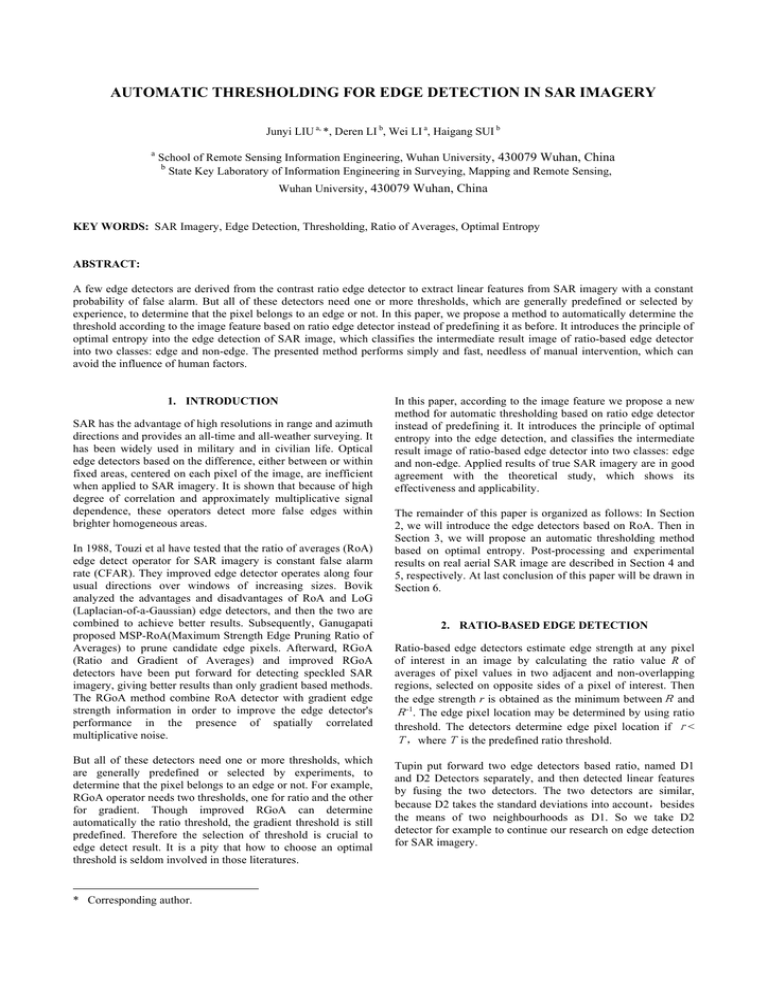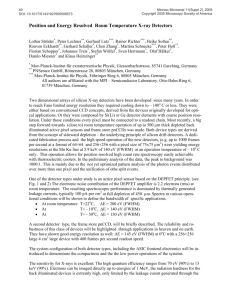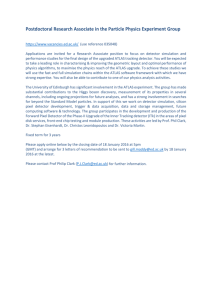AUTOMATIC THRESHOLDING FOR EDGE DETECTION IN SAR IMAGERY
advertisement

AUTOMATIC THRESHOLDING FOR EDGE DETECTION IN SAR IMAGERY Junyi LIU a, *, Deren LI b, Wei LI a, Haigang SUI b a School of Remote Sensing Information Engineering, Wuhan University, 430079 Wuhan, China b State Key Laboratory of Information Engineering in Surveying, Mapping and Remote Sensing, Wuhan University, 430079 Wuhan, China KEY WORDS: SAR Imagery, Edge Detection, Thresholding, Ratio of Averages, Optimal Entropy ABSTRACT: A few edge detectors are derived from the contrast ratio edge detector to extract linear features from SAR imagery with a constant probability of false alarm. But all of these detectors need one or more thresholds, which are generally predefined or selected by experience, to determine that the pixel belongs to an edge or not. In this paper, we propose a method to automatically determine the threshold according to the image feature based on ratio edge detector instead of predefining it as before. It introduces the principle of optimal entropy into the edge detection of SAR image, which classifies the intermediate result image of ratio-based edge detector into two classes: edge and non-edge. The presented method performs simply and fast, needless of manual intervention, which can avoid the influence of human factors. 1. INTRODUCTION SAR has the advantage of high resolutions in range and azimuth directions and provides an all-time and all-weather surveying. It has been widely used in military and in civilian life. Optical edge detectors based on the difference, either between or within fixed areas, centered on each pixel of the image, are inefficient when applied to SAR imagery. It is shown that because of high degree of correlation and approximately multiplicative signal dependence, these operators detect more false edges within brighter homogeneous areas. In 1988, Touzi et al have tested that the ratio of averages (RoA) edge detect operator for SAR imagery is constant false alarm rate (CFAR). They improved edge detector operates along four usual directions over windows of increasing sizes. Bovik analyzed the advantages and disadvantages of RoA and LoG (Laplacian-of-a-Gaussian) edge detectors, and then the two are combined to achieve better results. Subsequently, Ganugapati proposed MSP-RoA(Maximum Strength Edge Pruning Ratio of Averages) to prune candidate edge pixels. Afterward, RGoA (Ratio and Gradient of Averages) and improved RGoA detectors have been put forward for detecting speckled SAR imagery, giving better results than only gradient based methods. The RGoA method combine RoA detector with gradient edge strength information in order to improve the edge detector's performance in the presence of spatially correlated multiplicative noise. But all of these detectors need one or more thresholds, which are generally predefined or selected by experiments, to determine that the pixel belongs to an edge or not. For example, RGoA operator needs two thresholds, one for ratio and the other for gradient. Though improved RGoA can determine automatically the ratio threshold, the gradient threshold is still predefined. Therefore the selection of threshold is crucial to edge detect result. It is a pity that how to choose an optimal threshold is seldom involved in those literatures. * Corresponding author. In this paper, according to the image feature we propose a new method for automatic thresholding based on ratio edge detector instead of predefining it. It introduces the principle of optimal entropy into the edge detection, and classifies the intermediate result image of ratio-based edge detector into two classes: edge and non-edge. Applied results of true SAR imagery are in good agreement with the theoretical study, which shows its effectiveness and applicability. The remainder of this paper is organized as follows: In Section 2, we will introduce the edge detectors based on RoA. Then in Section 3, we will propose an automatic thresholding method based on optimal entropy. Post-processing and experimental results on real aerial SAR image are described in Section 4 and 5, respectively. At last conclusion of this paper will be drawn in Section 6. 2. RATIO-BASED EDGE DETECTION Ratio-based edge detectors estimate edge strength at any pixel of interest in an image by calculating the ratio value R of averages of pixel values in two adjacent and non-overlapping regions, selected on opposite sides of a pixel of interest. Then the edge strength r is obtained as the minimum betweenR and R-1. The edge pixel location may be determined by using ratio threshold. The detectors determine edge pixel location if r< T,whereT is the predefined ratio threshold. Tupin put forward two edge detectors based ratio, named D1 and D2 Detectors separately, and then detected linear features by fusing the two detectors. The two detectors are similar, because D2 takes the standard deviations into account,besides the means of two neighbourhoods as D1. So we take D2 detector for example to continue our research on edge detection for SAR imagery. Let index 2 denote the central region and index 1 and 3 both lateral regions in a 9×9 detect window (Figure 1). Firstly, the means( μ ,μ 1 2 , μ 3) and standard deviations ( 6 σ1 ,σ 2 , 5 4 3 7 σ 3 ) of three regions are calculated. 2 1 0 Figure 2. Directional pattern of edge detect 3. THRESHOLDING Figure 1. 9×9 detect window Then we define the response of the edge detector between region i and region j as Rij: Rij = sqrt (1 /(1 + (ni + n j ) * (ni * vi * 2 μi 2 μ j2 μ + n2 * v 2 ) /( ni * n j * ( i − 1) 2 ))) μj 2 Entropy is the measurement of uncertainty in information theory. Although the concept of entropy has been considered in image processing and pattern recognition applications, very little work has been carried out into the use of entropy in an edge operator. So in this paper, the concept of Shannon entropy is served for edge detection in SAR imagery. This method is used to calculate the entropy which has the maximum information and record the prompt gray value as the optimal global threshold for image edge detection. There are many different methods to measure the entropy. Below we briefly describe the method of Kapur et al. According to Shannon entropy, the entropy of an image graylevel may be written as: (1) L −1 where E = −∑ pi ln pi where vi = σ i / μ i where σi μi (3) i =0 ni = the pixel number in region i nj = the pixel number in region j vi = the variation coefficient of region (2) = the standard deviation in region i i = the gray-level value L = the number of different gray-level values pi = the frequency number of gray-level i The total probability Pt and entropy Et, which gray-level ranging from zero to t are shown as follow: = the mean in region i t Pt = ∑ pi The line detector D2 is defined by the minimum response r= min(R12 , R23). The central point of the detect window is selected as an edge pixel ifr>T, where T is a user selected global ratio threshold parameter. Considering the different direction of an edge, the detector responses have to be computed in eight directions at each pixel (Figure 2). And then the maximum of r is kept as the result. The size of window takes pixel number as unit, and the width of central region ranges from one pixel to half of the window width. For example, when a window of 9 × 9 is selected, responses are computed in eight directions and four different widths of the central line (widths ranging from 1 to 4 pixels are tested). Thus at each pixel, 32 different responses are obtained, the maximum of which will be stored as the final response, the corresponding direction will be kept as the edge direction of the pixel. So an image of ratio of averages can be achieved. (4) i =0 t Et = −∑ pi ln pi (5) i =0 Set t as supposed threshold, which segments the ratio of averages image into two classes: edge class class ω e and non-edge ω n . The distributing of them can be specified as follow: ωn : p 0 p1 p , ,..., t Pt Pt Pt (6) ωe : pt +1 pt + 2 p , ,..., L −1 1 − Pt 1 − Pt 1 − Pt (7) (a)horizontal (b)edge direction (c)sub-window Figure 3. Sketch of thinning The entropies of each distributing can be described as follow respectively: t E n (t ) = −∑ i =0 pi pi ln Pt Pt = InPt + H t / Pt (8) L −1 pi p ln i 1 − Pt i =t +11 − Pt E e (t ) = − ∑ ln(1 − Pt ) + = H − Ht 1 − Pt 5. EXPERIMENTAL RESULT (9) The entropy E(t) of an image can be expressed the sum of En(t) and Ee(t): E (t ) = ln Pt (1 − Pt ) + Ht H − Ht + Pt 1 − Pt After thinning, there are still some isolated points or short lines, which have little probability of belonging to an edge. So for each edge candidate point, according to its direction (i.e. direction 1 in Fig.2), we look for other candidate pixels with a direction (i.e., direction 0,1,2) close to this direction. Then the lengths of the short lines are recorded. Finally, we remove all the candidate pixels in the line which length is shorter than certain pixels and get a result image of edge detect. (10) In order to test the method proposed in this paper and compare with the other edge detectors, true aerial image with 3 meter resolution is detected by Canny, D2 and the proposed method respectively. Original image is shown in Figure 4, in which there is an airport. Detected results are shown from Figure 5 to Figure 9. Figure 5 is the result detected by canny operator. Though the edge of airport pavement is detected, there are many false edges. On the other hand, because of its nonconstant false alarm rate, it detects more false edges in high luminance homogeneous area (on the right of original image) than in low luminance homogeneous area (on the left of original image). So the discrete value T of t which maximizes E(t) is now the threshold value which maximizes the information between edge and non-edge. 4. POST-PROCESSING The edges detected by detectors based on RoA tend to generate thick edge maps, which results in low precision of edge orientation. Therefore, the paper improves the MSP-RoA algorithm proposed by Ganugapat to thin the result image obtained by the method above. As the edge point detected by above method records the orientation information, we defines a sub-window of size 3×1 centred on a candidate pixel of interest and perpendicular to its direction. Figure 3 explains how to define sub-window when the central point’s direction is horizontal. The other seven directions can be reasoned by analogy. The maximum value of the pixels in the sub-window is selected as the measure of the edge strength for the local area. The candidate pixel at the centre of the sub-window is selected as an edge pixel if its r value equals to maximum; otherwise, the centre pixel is rejected as a candidate edge pixel. This process tends to thin edge maps that would otherwise be thick, while maintaining a good continuity of edge line along edges. Figure 4. Original image Figure 5. Detected result of Canny (a) Florence Tupin, Henri Maitre, Jean-Francois Mangin, JeanMarie Nicolas, and Eugene Pechersky,1998. Detection of linear features in SAR images: application to road network extraction. IEEE Transactions on Geoscience and Remote Sensing. 36(2),pp.434-453. J.N.Kapur, P.K.Sahoo, A.K.C.Wong, 1985. A new method for gray-level picture thresholding using the entropy of the histogram. Computer Vision, Graphics and Image Processing.29(2),pp.273-285. (b) Figure 6. Detected result of D2 S.S Ganugapati and C.R.Moloneym,1995. A ratio edge detector for speckled images based on maximum strength edge pruning. Proceedings of International Conference on Image Processing.(2),pp.165-168. Zhengyao Bai, Peikun He,2003. An improved ratio edge detector for target detection in SAR images. IEEE Int.Conf.Neural Networks & Signal Processing. 12,pp,982-985. 7. ACKNOWLEDGEMENTS (a) (b) Figure 7. Detected result of proposed method Figure 6 is the detected result by D2 operator with an experiential threshold, which detects most of the edges and a lot of false edges. Its edges are thick. Figure 7 is obtained by the proposed method. It keeps the characteristic of CFAR, i.e., the false rate in homogeneous areas with different gray is uniform. At the same time, the false edges on airport pavement and the homogeneous in the middle of airport resulting from speckle are suppressed hugely. For the sake of displaying the results clearly, the detected results of the corner (red rectangle in original image) are zoomed in and shown in Figure 6(b) and Figure 7(b). From the corner of airport, it can be seen that the proposed method is of high edge location precision and false edges are suppressed hugely. 6. REFERENCES A.C.Bovik,1988. On detecting edges in speckle imagery. IEEE Trans ASSP.36(10),pp.1618-1627. C.J.Oliver, D.Blacknell, R.G.White,1996. Optimum edge detection in SAR. IEE Proc-Radar. Sonar Navig. 143(1), pp.3140. The authors would like to thank the 38th Research Institute, China Electronic Technology Group Corporation for providing the aerial SAR image.




